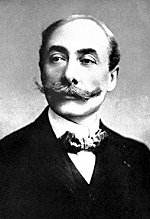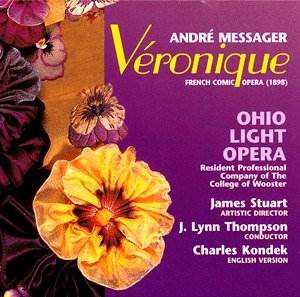
Opéra-comique commenced initially with works written in the early
19th century. Offenbach is the composer most associated with
this genre of light, frothy, flowery, bright and easily accessible music.
Building on the fun surrounding Auber’s Fra Diavalo, Offenbach
lit the way for equally fresh composers who wished to try their luck
in writing for the stage in this novel genre. In Britain Offenbach’s
opéra-comique was eventually eclipsed by the rise of the Savoy
comic operas of Gilbert and Sullivan two decades later. Yet it was Messager’s
La Basoche which rescued D’Oyly Carte’s new English Opera House
when no English work was ready to replace the theatre’s opening opera,
Ivanhoe (Sullivan). He had followed the Offenbach style with
much success. Of Messager’s works, Veronique is the one best
remembered in Britain, partly because Eric Robinson exposed the hit
Veronique song, ‘Here and There’ (De ci, de là)
in BBC Television’s early orchestral concerts and it soon got played
elsewhere.
André Messager was born in central France
at Moutluçon. With a musical interest in keyboard instruments
he had a leaning to the organ. He studied at the Ecole Niedermeyer under
the eminent masters Saint Saëns and Fauré who became his
lifelong friends. By 1878, when 25 he had a symphony performed and was
writing prize-winning cantatas. In contrast to this serious output,
he provided little divertissements, like the ballets for the Folies
Bergère, which provided useful income. His rise to fame came
with two opéra-comiques written in 1885– La Fauvette du Temple
and La Béarnaise, both of which received long runs and
were exported to London and New York. The critics liked his orchestration
since it revealed a classical suppleness and charm somewhat lacking
in the French compositions of Planquette and Lecocq, performed alongside
Offenbach. Five years later his compositions were at their best. In
1890, La Basoche played at the Opéra-Comique and opened
a new chapter with a score was considerably stronger than his usual
stage compositions. (No recording of the work exists, though it was
broadcast by the BBC under Beecham? in the 1920s.)
Véronique opened in 1898 and was set
in a romantic period of French fashion, the 1840s, which had some appeal
to French audiences in itself. The plot is a love story surrounding
two central characters, Florestan and Véronique. After a vibrant
overture, the operetta takes little time to warm up. For the entrance
of Hélène (Véronique) Messager is musically at
his strongest, using wind and strings to provide a perfect and magical
effect. Florestan appears with a lilting song, which is not particularly
inventive and is similar to songs from the pen of Lecocq or Planquette.
But this contrasts nicely with Messager’s ambitiously written quartet,
Charmant, charmant that follows. The Act 1 finale is recognisably
Offenbach-ish in rhythm. Two hits are the catchy – De ci, de là
(Trot here, trot there) (mentioned above), and a flowery Swing
song, heard later. Act 3 is notable for its comic duet with a refrain
that wins Messager to the heart. Messager’s compositions are elegantly
light in orchestral colour, and generally have a vocal line often shadowed
by the orchestra (à la Offenbach). His gift lies in warm melodies
and harmonies that are easy on the ear. A musical director has to feel
the Parisian lilt if the tunes are to hold their magic. Florestan’s
Air, ‘Every shop girl is a beauty’ (CD2 tk6) has a tune whose source
was probably "He’s a how-di-do" (Mikado) written 12 years
earlier. Elsewhere Messager has musical phrases which also seem to have
been borrowed from the Savoy operas (CD2 tk8.20" in). One of the
most impressive tunes of Véronique is the one which starts the
overture.
The soloists both sing and act well with the required
element of fun included. Susan Miller as Hélène/Véronique
is a light soprano and Ted Christopher (Florestan) a robust tenor, both
with fine vibrato. Susan Miller has slight difficulty with a few sustained
notes at the end of lines, but this does not mar her performance. The
couple complement each other well (hear them in the Act II duet, "Now
you’re laughing" (CD2 tk2). Amy Warchol (Denise) has excellent
diction: her singing is good but her consonants can be edgy. The orchestra
play well throughout and only once (in the Act 3 Entr’acte; CD2 tk9)
did I consider the strings decidedly thin. Lynn Thompson keeps a lively
pace and does find some of the French nuances of Messager’s lush score,
but tends to gloss over the dynamic changes heard in the EMI recording.
John Ostendorf’s production is lively and fast moving with committed
actors who bring realism to their parts.
Why the opening chorus runs on from the overture without
a track change I don’t know since this is not normal practice. The 2
CD set is taken from a live stage performance. During the dialogue sections
the stage movement is very obvious and is at times distracting. However,
only once did this interfere with the singing and so can be dismissed
without much worry. (This is not the case on many other Ohio productions
where the recording is first class throughout.) The balance between
singers and orchestra at times becomes less than ideal. This is particularly
noticeable in ‘Trot Here, Trot There’ (‘Hee-haw, Hee-haw’) where the
delicate accompaniment is drowned.
The notes in English come with a complete libretto
of a translation by Charles Kondek. The dialogue works well but there
are some odd lyrics – "De ci, de là" is translated
as ‘Here and there’ which to fit the music is expanded to "Trot
here, trot there". In this translation it is changed to a cumbersome
"Hee-haw! Hee-haw! Clip, clip-clopping". The notes do not
tell us why they felt they had to provide another English translation.
Further reading: "Operetta", Traubner (Oxford);
‘Musicals", Ganzl (Carlton)
Raymond Walker


